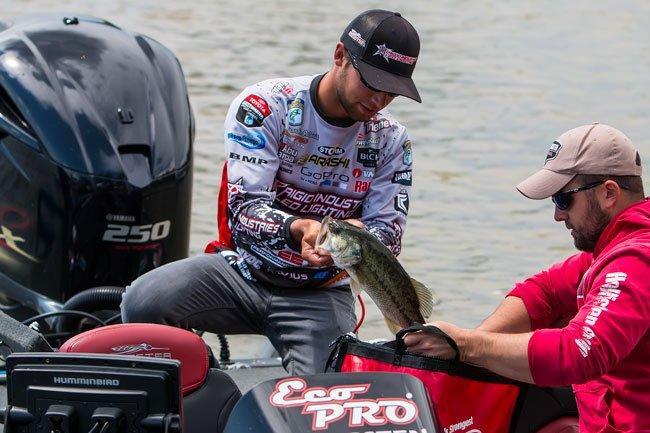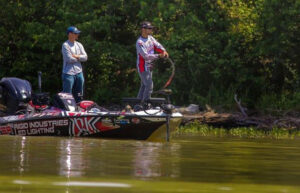As water temperatures increase this summer and bass’ bodies begin burning more calories, they have a fairly simple goal in life—to get a full belly without exerting too much energy. Compound this unpretentious existence with decreased oxygen levels and poor water quality and you’ll soon have all the ingredients for a frustrating day on the water.
According to Elite Series pro Brandon Palaniuk, however, there happens to be a still point in this period of late-summer volatility. If you can locate some well-placed grass lines on your favorite fishery, you’re likely to find yourself in the middle of a gourmet bass buffet.
Opportunism at its best
“Work smarter, not harder” is a phrase used by many in today’s culture. It suggests that, instead of putting in unnecessary effort to reach a goal, we should instead find more efficient avenues to reach the same outcome. Bass are programmed with a very similar mentality throughout the late-summer.
“Bass get fat and healthy by waiting for their food to come to them, making grass lines a perfect hiding spot. They don’t have to do much– they just pop out, open their mouths and slide back in.”
“Bass are very opportunistic ambush feeders,” Palaniuk said. “They get fat and healthy by waiting for their food to come to them, making grass lines a perfect hiding spot. They don’t have to do much—they simply position their bodies inside the grass with their noses sticking out so when prey cruises by, all they have to do is pop out, open their mouths and slide back in. The more energy they can conserve, the better.”
In addition to acting as a perfect ground blind—for all you hunters out there—grass lines also provide bass with very two very important opportunities. They’re able to cool off while being in extraordinarily close proximity to one of their favorite summertime feasts.
Cooler water—“Even though bass are a warm water species, the largest bass in a body of water prefer cooler temperatures,” Palaniuk said. “The shade from these grass beds results in significantly lower temperatures which, in turn, makes them more likely to aggressively feed.”Bluegill—“Throughout the summer, there’s a lot of bluegill spawning activity going on,” Palaniuk said. “Even if they’re done spawning, they’ll still hang around in the shallows. There have been many times I’ve seen bigger bass prefer bluegill instead of shad and I think it’s because shad are harder to catch. If a bass can get a bigger meal without an exhausting chase, they’ll be all over it.”
Factors to consider
Like most bass fishing techniques, there are specific factors and conditions that tend to facilitate anglers in our search for a productive grass line bite. Mother Nature and water conditions may be the most important variables to consider.
Weather—“You can certainly catch some good ones targeting grass lines on sunny days, but the best action tends to happen on cloudy or rainy days,” Palaniuk said. “Bass feel much more comfortable positioning themselves near open water under dark skies, which makes them more likely to venture out from the perceived security the middle of a grass bed offers.”Current—“Although bass have a pea-sized brain, they’re very aware of environmental cues,” Palaniuk said. “The more current there is, the more apt they are to feed on the edges of grass. Remember, they’re opportunistic feeders so they’ll let that moving water wash their food right to them. It’s easy pickings and they know it.”Water levels—“In most cases, bass are going to move with the water levels,” Palaniuk said. “So when the water level drops, they’ll likely slide out to the outside grass lines. Conversely, rising water often puts them inside and underneath grass beds.”
We all have that fishing buddy who, after wrecking ‘em in the grass a time or two, comes up with all kinds of reasons the fish were there. They might say it’s where the bearded donkey grass met the gorilla grass or they’ll claim the bass were positioned wherever the Manila cross-joined the hydrilla—or something like that.
While Palaniuk acknowledges that super-specific patterns can actually be legitimate, he believes the most consistent thing to look for is “clean” grass.
“The types of grass lines on which bass position can change weekly, daily and sometimes hourly,” Palaniuk said. “Generally speaking, they’ll prefer a mixture of grass simply because it’s an irregularity. But day-in and day-out, you need to be looking for clean, crispy grass because it provides cleaner water in the area, better oxygen levels and attracts more bait.”
So now what? Your favorite lake has a bunch of sexy grass lines full of crisp, green grass, so they probably all host big bass, right? Well, not exactly. Palaniuk is a big believer in map study and his reasoning makes perfect sense.
“From what I’ve found, summertime bass use contour lines and depth changes as highways to move to and from shallow water,” Palaniuk said. “So I spend a lot of time on my Navionics card looking for little turns where the contour lines get a little closer. This means there is deeper water nearby, which allows the fish to pull up onto the grass lines to feed and slide out to deeper water when the want to relax a bit.”
How to make ‘em eat
When they’re really chewing, there are probably dozens of techniques you could use to catch a few bass on grass lines. But what happens when it gets tough this time of year? We already know these finicky bass aren’t as likely to chase down a meal, so it’s important to use high-percentage techniques that take advantage of the bass’ biggest weaknesses.
“I’ll start by making 45-degree casts to the grass lines so I can optimize my time in each strike zone. When I find out where they’re positioned, that’s when I’ll start paralleling them.”
Throughout his travels across the country, Palaniuk has developed a lot of confidence in the follow techniques.
Hollow-bodied frog—“When I’m just starting to search for a grass line bite, I’m going to have a frog tied on at all times,” Palaniuk said. “I’m able to cover a bunch of water efficiently and draw reaction strikes from nearby bass. Because it’s such a weedless approach, I can quickly discern where they’re positioned, which tells me where I should concentrate my efforts.”Pitching and flipping—“On sunny days or when the bass are relating to thicker clumps of grass near the edges, I catch a lot of big ones on a Texas rigged Berkley Havoc Pit Boss rigged on a 4/0 VMC Heavy Duty Flippin Hook and a 1/2-ounce Eco Pro Tungsten Flipping Weight,” Palaniuk said. “I fish it very quickly by making a pitch, shaking it three or four times after hitting the bottom, reeling it in and repeating the process. This is a great way to catch ‘em when they’re not aggressively feeding.”Squarebill crankbait—“If I know they’re on the grass lines, I love paralleling ‘em with a Series 3 or 5 Storm Arashi Rattling Square Bill,” Palaniuk said. “I don’t tell people this very much, but in the late summer you can burn this crankbait as fast as you can in these areas for some ridiculous strikes. It just triggers their predatory instincts—they don’t even have time to decide to eat it.”Drop shot—“In clear, shallow water, it can be tough to catch grass line bass with loud, overpowering techniques,” Palaniuk said. “If I see ‘em following my other baits without committing, I’ll flip a drop shot to them. I wacky rig a Berkley Havoc Money Maker on a 1/8-ounce Eco Pro Tungsten Full Contact Drop Shot Weight with an 8-inch, 8-pound Berkley Trilene 100% Fluorocarbon leader. I can keep a good distance from the grass line and shake that Money Maker while keeping it in the strike zone. If I know I’m around a concentration of fish, this is a definite mainstay in my arsenal.”
Do yourself a favor—ride around your lake, study some contour lines and locate some grass lines the next time you get out there. If you can find the “right” grass and make a game plan in accordance to the conditions, you shouldn’t have much trouble getting some quality bites.














